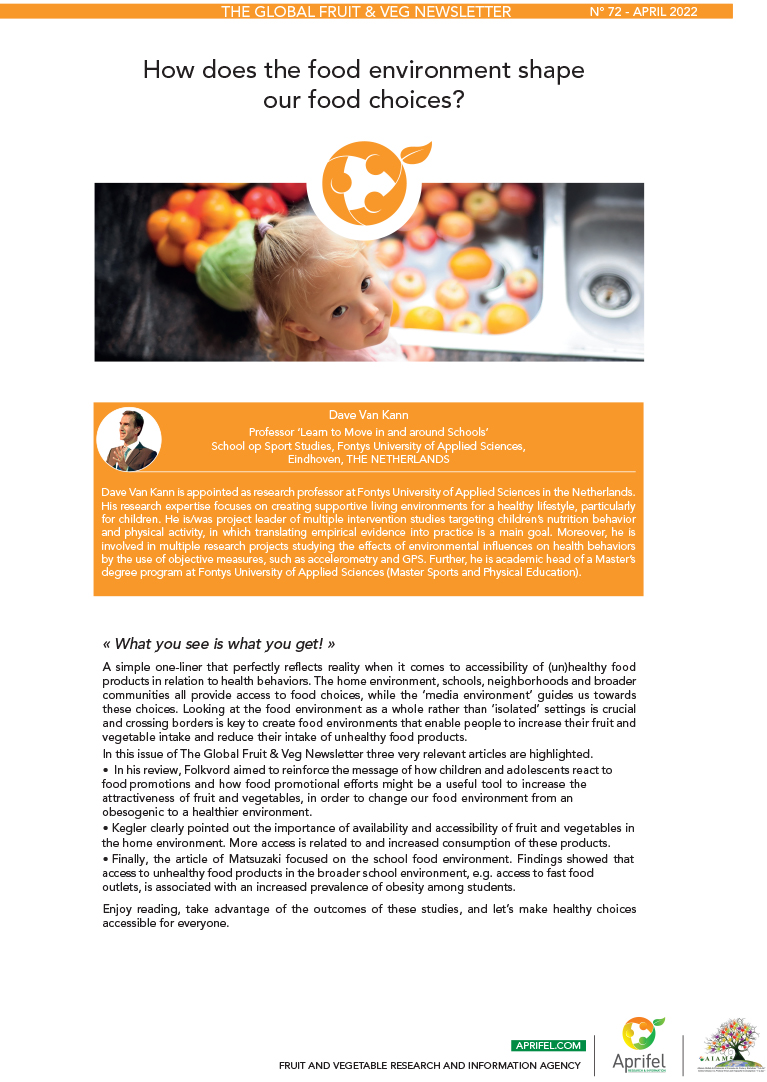Influencing for the good: Promoting fruit and vegetable consumption could improve children’s food intake and reverse the obesogenic food environment

Children’s media environment is full of representations of unhealthy and energy-dense food products, having harmful effects on children’s eating behavior. In addition, mounting evidence suggests that when food is positively shown in advertising then this product is significantly more likely to be a non-core, unhealthy food, compared to a fruit or vegetable . Nowadays, the YouTube videos of influencers, that are extremely popular among young people, have been found to often feature unhealthy food cues, described positively with reference to social contexts. As a consequence, the majority of children worldwide do not consume the recommended amount of fruit and vegetables (Folkvord, 2016; Matthes, 2019).
The main aim of this review is to reinforce the message of how children and adolescents react to food promotions and how food promotional efforts might be a useful tool to increase the attractiveness of fruit and vegetables, in order to change our food environment from an obesogenic to a healthogenic environment.
Products high in fat, sugar and salt account for 65-80% of all food marketing
There is ample evidence that the presentation of unhealthy foods is connected to children’s and adolescents’ unhealthy food choices. Particularly young children and adolescents might be vulnerable to long-term negative effects of unhealthy food promotion as they are exposed to extensive marketing efforts on social media and are not typically covered by regulatory efforts. Unhealthy foods have higher intrinsically rewarding properties that make them more “wanted” and “liked” than fruit and vegetables, thereby inducing unhealthy eating behavior among children and reducing their intake of healthier foods.
Additionally, promotion for unhealthy foods is omnipresent and increases the rewarding value of these foods. Studies consistently found that products high in fat, sugar and salt (HFSS) were the main type of products advertised in media popular with children. According to content analyses, HFSS products account for 65-80% of all food marketing in digital media (including social media) which is currently children’s preferred media. In addition, studies have indicated that the majority of foods promoted by influencers are classified as being unhealthy, and that this marketing significantly impacts young people’s food consumption. The World Health Organization asserts that the promotional strategies used in the pervasive and persuasive marketing of HFSS foods contribute significantly to the childhood obesity crisis (WHO, 2019).
Promoting fruit and vegetable consumption could improve their intake among children
A limited amount of research suggest that it is challenging to increase fruit and vegetables intake among children, especially over the long term. Fruit and vegetables are less intrinsically rewarding than HFSS foods, considering the automatic physiological (e.g., saliva, increased activation in brain areas related to reward and food motivation systems) and psychological (e.g., craving, hunger, liking and wanting) reactivity that HFSS foods induce. Additionally, the food industry uses incessant, sophisticated, and personalized advertising to effectively increase the hedonic and rewarding value of HFSS foods by modifying attitudes, emotions, intentions, and ultimately consumption behavior, while these strategies are lacking to promote fruit and vegetables. Nonetheless, several studies have shown that exposure to fruit and vegetables can be stimulated by simply exposing children at a very young age.
Therefore, there is an urgent need to systematically test novel and effective methods to make fruit and vegetables more appealing and increase the intake among children through influencing for the good in order to improve children’s eating behavior. While there are many strategies involved in making them desirable for children, for instance health-literacy programs in schools, or parents’ communication strategies and feeding practices, a whole-systems approach is often cited as being fundamental to creating an environment whereby the healthy choice is the easy choice. While the personal environment, and thus family practices, are crucial to the socialization of a health-promoting environment, this is an area that is difficult to intervene in directly.
Creating a World where the healthy choice the easy one
Interventions from the public sphere are needed to create a health-promoting environment that also affect the private space. For example, in addition to a ban on unhealthy food marketing, radical interventions on price, product composition, labelling and the availability of junk food are needed to see an impact. Recently, the COVID-19 pandemic has highlighted the importance of a healthy food environment. The current globalized food system cannot sustainably promote healthy people and a healthy planet without significant actions being implemented.
- Reducing the marketing of energy‐dense snacks to children and increasing the promotion of healthier foods, such as fruit and vegetables, may be an effective and necessary instrument to improve the dietary intake of children and reduce the risk of their experiencing some chronic diseases later in life.
- Changing the advertising and media environment of children and adolescents could help create a world where the healthy choice is the easier choice, which would reduce childhood obesity and improve children’s health, as well as to make the food system more sustainable.
Based on : Folkvord, F., Naderer, B., Coates, A., & Boyland, E. (2022). Promoting Fruit and Vegetable Consumption for Childhood Obesity Prevention. Nutrients, 14(1), 157.

